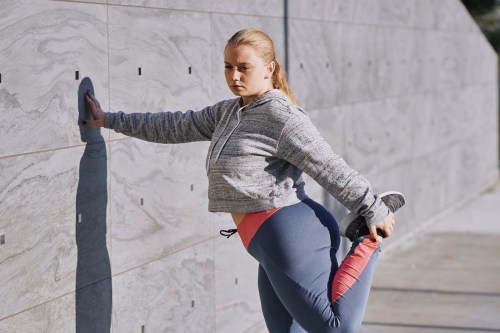“You’re overtraining,” was the first thing celebrity fitness trainer Harley Pasternak (who’s worked with Kim Kardashian, Jennifer Lopez, and Rihanna) told me upon meeting him. It’s not because I’m super ripped or anything, but after explaining my current workout regimen to him, he shook his head, and told me to cool it.
What was the grand clue? I wake up every single day and am sore. “Prolonged muscle soreness is a big warning of overtraining,” says Pasternak, who personally does strength training three days a week supplemented with walking everywhere. “Resistance exercise is like taking antibiotics. You need a specific dose, for a specific duration, at a specific intensity. So if the doctor says take one for the next ten days, and you try taking two a day for five days to work faster, it’s not going to.”
“If you tear the muscles and then 48 hours later tear them again (and again), you create macro tears.” —Harley Pasternak
So, yeah—I’m not looking to sabotage all this hard work I’m putting into in my fitness game. Not only that, but overtraining can even potentially lead to injury. “Strength training and plyometric are designed to challenge a muscle and muscle groups enough where you overload it,” says Pasternak. “When you overload, you’re tearing the fibers—which is a good thing. They’re mico-tears, and when they heal, they heal stronger than before. But if you tear the muscles and then 48 hours later tear them again, you create macro tears.” And that means that inflammation gets involved in the mix. “This means significant inflammation that will be prolonged and systematic, so you can even start feeling lethargic and tired, even after good sleep,” says Pasternak, noting that it can also heavily impact your connective tissues.
“When you’re always sore, it goes to your ligaments and your tendons, so you can get tendinitis or tendinosis, it can effect your biomechanics or your gait,” he adds. “Because of the chronic muscle pain, it’ll change the way your body moves, and you’ll go into a compensation cycle.” Yeah, no thanks. So how can I rectify the overtraining situation? It’s all about recovery.
Pasternak’s 5 key ways to recover from overtraining.
1. Active rest: It sounds contradictory, but “active rest” is a thing—and Pasternak says it’s key between workouts. “Walk—take long walks,” he says. “It sounds sub-maximal, but there’s nothing in life that’s more effective in the world than walking.” Pasternak himself recommends that all of his clients walk a minimum of 12,000 steps per day.
2. Hydration: “Really hydrate,” says Pasternak. “I have inflammation markers right now, which is where pain is coming from—they’re called prostaglandins, which is a category of inflammation hormones. It’s your body’s inflammation response to trauma. A little is good, but constant is not good.” So he says that hydration is important so you can flush these out of your body, which movement will help do also.
3. Massage: When your muscles are tight, nothing’s better than a healing massage. “Massage can be helpful as long as it’s not overly intense,” says Pasternak. “Foam rolling is an option.” He also recommends applying CBD topically, particularly from CBDMedic (a brand he both uses and reps), which makes all sorts of topical pain relief lotions. “Your body has CBD receptors, so used on pain helps your body through recovery,” he says.
4. Nutrition: Eating the right nourishing foods is also key so that your body has the nutrients and tools necessary in order to repair itself. Think leafy greens and sufficient protein, and avoid inflammatory foods like sugar and dairy. “Get enough [nutrition] to help rebuild muscle and help with inflammation,” says Pasternak.
5. Sleep: One of the biggest recovery methods of all? Catching enough ZZZs. Make sure your shut eye adds up to roughly seven to eight hours, and your body will have enough time to repair itself. Welp, sounds like I have an excuse to take a legit rest day.
If you’re overtraining, it could also be why you’re not getting stronger. And here’s more intel about the connection between muscle soreness and inflammation.
Sign Up for Our Daily Newsletter
Get all the latest in wellness, trends, food, fitness, beauty, and more delivered right to your inbox.
Got it, you've been added to our email list.











